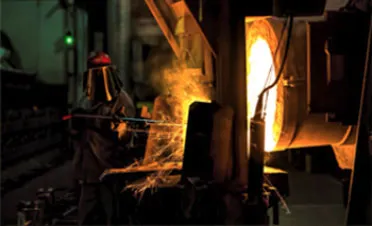zinc high pressure die casting
High Pressure Die Casting of Zinc An Overview
High pressure die casting (HPDC) of zinc is a prominent manufacturing technique used to create complex, high-precision components in various industries, including automotive, electronics, and consumer goods. Zinc alloys, particularly zinc-aluminum and zinc-copper combinations, are widely favored due to their excellent mechanical properties, corrosion resistance, and superb casting characteristics. This article explores the advantages, processes, and applications of high pressure die casting using zinc.
Advantages of Zinc in HPDC
1. Exceptional Casting Fluidity Zinc has a low melting point (around 420°C), allowing it to fill intricate molds easily. This fluidity results in high-quality surface finishes and minimizes defects such as porosity and shrinkage.
2. Fine Detail Reproduction The high pressure applied during the casting process allows for the production of intricate designs and fine details that would be challenging to achieve with other materials. This capability opens up new design possibilities for manufacturers.
3. Mechanical Properties Zinc alloys exhibit good mechanical strength, ductility, and toughness. They maintain structural integrity under varying temperatures and loads, making them ideal for components subjected to stress.
4. Corrosion Resistance Zinc naturally forms a protective oxide layer, providing excellent resistance to corrosion. This property extends the lifespan of components used in outdoor and aggressive environments.
5. Sustainability Zinc is 100% recyclable without loss of performance, making it an eco-friendly material choice for manufacturers aiming to reduce their environmental impact.
The High Pressure Die Casting Process
The HPDC process involves several critical steps, each crucial to ensuring the production of high-quality zinc components
1. Mold Preparation Molds, typically made of hardened steel for durability, are pre-heated to minimize thermal shock. Proper lubrication is applied to facilitate easy removal of the finished part.
zinc high pressure die casting

2. Injection Molten zinc is injected into the mold at high pressures (up to 1000 bar) through a horizontal or vertical shot chamber. This pressure forces the zinc to fill the mold cavity rapidly, ensuring complete detail reproduction.
3. Cooling and Solidification Once the mold is filled, the molten zinc cools rapidly, solidifying into a precise shape. Cooling times can vary based on the component's thickness and the specific zinc alloy used.
4. Ejection After solidification, the mold is opened, and hydraulic ejection systems push the finished component out. This step must be performed delicately to avoid damaging detailed features.
5. Post-Processing The components often require additional finishing steps, such as trimming, deburring, and surface treatments to enhance appearance and durability. Techniques like powder coating, plating, or anodizing are commonly employed to add corrosion resistance and aesthetic value.
Applications
The versatility of zinc die casting makes it suitable for a wide range of applications
- Automotive Components HPDC is used for creating parts like engine blocks, housings, and gears, where lightweight and strength are critical. - Consumer Electronics Many electronic housings, connectors, and brackets are produced using zinc die casting due to their reliable performance and excellent thermal conductivity.
- Industrial Equipment Components used in machinery and tools benefit from the durability and corrosion resistance provided by zinc die casting.
- Medical Devices Precision components for medical instruments often utilize HPDC for their required robustness and accuracy.
Conclusion
High pressure die casting of zinc is a valuable manufacturing process that combines efficiency, precision, and material properties beneficial across various industries. The continued development of zinc alloys and die casting technology is expected to enhance capabilities further, ensuring that manufacturers can produce increasingly complex and durable components. As industries worldwide strive for sustainability, the recyclable nature of zinc makes it a particularly attractive choice for future production needs. Thus, zinc HPDC stands as a testament to innovation in modern manufacturing techniques, paving the way for advancements in numerous applications.
-
Precision Sheet Metal Stamping Manufacturer | Fast & ReliableNewsAug.01,2025
-
OEM Sand Cast Pump Valve Fittings - Baoding Hairun Machinery And Equipment Trading Co., Ltd.NewsAug.01,2025
-
Custom OEM Impellers | High Efficiency & PrecisionNewsAug.01,2025
-
OEM Sand Cast Pump Valve Fittings - Baoding Hairun Machinery | Customization, Quality AssuranceNewsAug.01,2025
-
OEM Sand Cast Pump Valve Fittings - Baoding Hairun Machinery And Equipment Trading Co., Ltd.NewsAug.01,2025
-
OEM Sand Cast Pump Valve Fittings - Baoding Hairun Machinery And Equipment Trading Co., Ltd.NewsJul.31,2025















